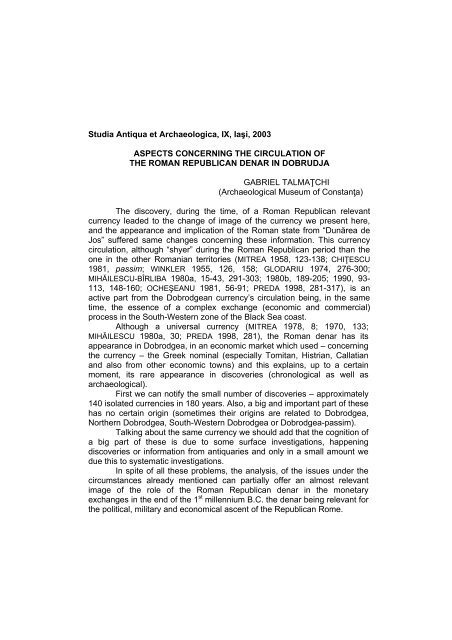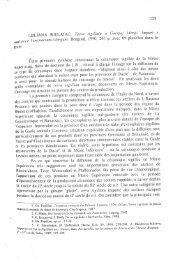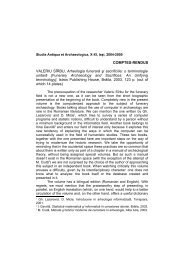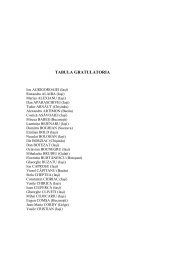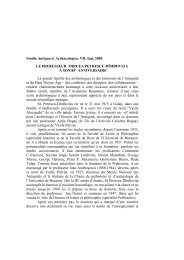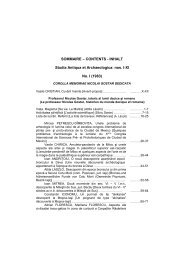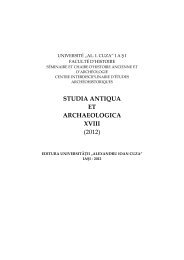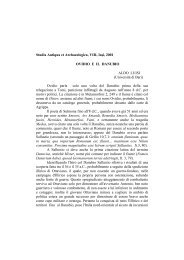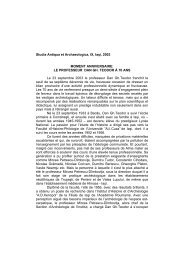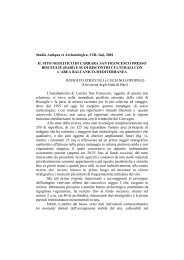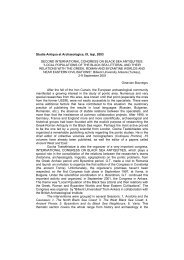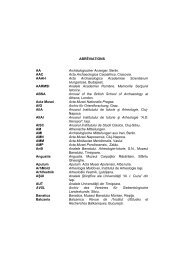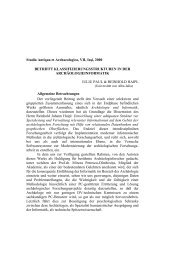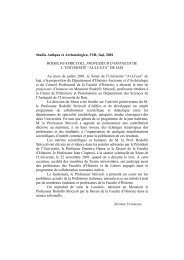aspects concerning the circulation of the roman republican in ... - CISA
aspects concerning the circulation of the roman republican in ... - CISA
aspects concerning the circulation of the roman republican in ... - CISA
Create successful ePaper yourself
Turn your PDF publications into a flip-book with our unique Google optimized e-Paper software.
Studia Antiqua et Archaeologica, IX, Iaşi, 2003<br />
ASPECTS CONCERNING THE CIRCULATION OF<br />
THE ROMAN REPUBLICAN DENAR IN DOBRUDJA<br />
GABRIEL TALMAŢCHI<br />
(Archaeological Museum <strong>of</strong> Constanţa)<br />
The discovery, dur<strong>in</strong>g <strong>the</strong> time, <strong>of</strong> a Roman Republican relevant<br />
currency leaded to <strong>the</strong> change <strong>of</strong> image <strong>of</strong> <strong>the</strong> currency we present here,<br />
and <strong>the</strong> appearance and implication <strong>of</strong> <strong>the</strong> Roman state from “Dunărea de<br />
Jos” suffered same changes <strong>concern<strong>in</strong>g</strong> <strong>the</strong>se <strong>in</strong>formation. This currency<br />
<strong>circulation</strong>, although “shyer” dur<strong>in</strong>g <strong>the</strong> Roman Republican period than <strong>the</strong><br />
one <strong>in</strong> <strong>the</strong> o<strong>the</strong>r Romanian territories (MITREA 1958, 123-138; CHIŢESCU<br />
1981, passim; WINKLER 1955, 126, 158; GLODARIU 1974, 276-300;<br />
MIHĂILESCU-BÎRLIBA 1980a, 15-43, 291-303; 1980b, 189-205; 1990, 93-<br />
113, 148-160; OCHEŞEANU 1981, 56-91; PREDA 1998, 281-317), is an<br />
active part from <strong>the</strong> Dobrodgean currency’s <strong>circulation</strong> be<strong>in</strong>g, <strong>in</strong> <strong>the</strong> same<br />
time, <strong>the</strong> essence <strong>of</strong> a complex exchange (economic and commercial)<br />
process <strong>in</strong> <strong>the</strong> South-Western zone <strong>of</strong> <strong>the</strong> Black Sea coast.<br />
Although a universal currency (MITREA 1978, 8; 1970, 133;<br />
MIHĂILESCU 1980a, 30; PREDA 1998, 281), <strong>the</strong> Roman denar has its<br />
appearance <strong>in</strong> Dobrodgea, <strong>in</strong> an economic market which used – <strong>concern<strong>in</strong>g</strong><br />
<strong>the</strong> currency – <strong>the</strong> Greek nom<strong>in</strong>al (especially Tomitan, Histrian, Callatian<br />
and also from o<strong>the</strong>r economic towns) and this expla<strong>in</strong>s, up to a certa<strong>in</strong><br />
moment, its rare appearance <strong>in</strong> discoveries (chronological as well as<br />
archaeological).<br />
First we can notify <strong>the</strong> small number <strong>of</strong> discoveries – approximately<br />
140 isolated currencies <strong>in</strong> 180 years. Also, a big and important part <strong>of</strong> <strong>the</strong>se<br />
has no certa<strong>in</strong> orig<strong>in</strong> (sometimes <strong>the</strong>ir orig<strong>in</strong>s are related to Dobrodgea,<br />
Nor<strong>the</strong>rn Dobrodgea, South-Western Dobrodgea or Dobrodgea-passim).<br />
Talk<strong>in</strong>g about <strong>the</strong> same currency we should add that <strong>the</strong> cognition <strong>of</strong><br />
a big part <strong>of</strong> <strong>the</strong>se is due to some surface <strong>in</strong>vestigations, happen<strong>in</strong>g<br />
discoveries or <strong>in</strong>formation from antiquaries and only <strong>in</strong> a small amount we<br />
due this to systematic <strong>in</strong>vestigations.<br />
In spite <strong>of</strong> all <strong>the</strong>se problems, <strong>the</strong> analysis, <strong>of</strong> <strong>the</strong> issues under <strong>the</strong><br />
circumstances already mentioned can partially <strong>of</strong>fer an almost relevant<br />
image <strong>of</strong> <strong>the</strong> role <strong>of</strong> <strong>the</strong> Roman Republican denar <strong>in</strong> <strong>the</strong> monetary<br />
exchanges <strong>in</strong> <strong>the</strong> end <strong>of</strong> <strong>the</strong> 1 st millennium B.C. <strong>the</strong> denar be<strong>in</strong>g relevant for<br />
<strong>the</strong> political, military and economical ascent <strong>of</strong> <strong>the</strong> Republican Rome.
274 GABRIEL TALMAŢCHI<br />
As we already know, <strong>the</strong> currency is <strong>in</strong>deed an <strong>in</strong>stitution that<br />
depended, dur<strong>in</strong>g <strong>the</strong> ancient times, upon <strong>the</strong> general political context as<br />
well as <strong>the</strong> economical one. The Roman Republican denar, be<strong>in</strong>g <strong>the</strong><br />
exponent <strong>of</strong> a powerful state that was <strong>in</strong> a permanent expansion, had been<br />
variable accepted <strong>in</strong> Dobrodgea (tak<strong>in</strong>g <strong>in</strong> account <strong>the</strong> zone and <strong>the</strong> time),<br />
be<strong>in</strong>g supported by <strong>the</strong> trust <strong>of</strong> <strong>the</strong> ones which accepted it for <strong>the</strong> payment<br />
<strong>of</strong> <strong>the</strong> products and cont<strong>in</strong>ued to use or treasure it.<br />
The <strong>in</strong>terest directions <strong>concern<strong>in</strong>g</strong> <strong>the</strong> Republican denar`s discovery<br />
are: <strong>the</strong> right shore <strong>of</strong> <strong>the</strong> Danube, <strong>the</strong> seacoast <strong>of</strong> <strong>the</strong> Pontus Eux<strong>in</strong>us and<br />
<strong>the</strong> <strong>in</strong>side territory between <strong>the</strong> Danube and <strong>the</strong> Sea (OCHEŞEANU 1971,<br />
83; POENARU-BORDEA 1974, 219-230; TALMAŢCHI 1998, 279-280). The<br />
last direction, <strong>in</strong> fact <strong>the</strong> central part is, accord<strong>in</strong>g to <strong>the</strong> present datum, <strong>the</strong><br />
less favored one for <strong>the</strong> prospect <strong>of</strong> our research – we can f<strong>in</strong>d <strong>the</strong>m as<br />
treasures as well as isolated. Suppositional we can say that this zone had a<br />
natural difficulty – we are talk<strong>in</strong>g about <strong>the</strong> South – Eastern Dobrodgean<br />
zone – expla<strong>in</strong>ed for that time, by <strong>the</strong> presence <strong>of</strong> an extremely dense<br />
vegetation made <strong>of</strong> bushes, very hard to be passed by merchants<br />
(HAIMOVICI 1999, 219; CHIRIAC, PAPASIMA 2000, 222). We can notify that<br />
this situation, <strong>concern<strong>in</strong>g</strong> <strong>the</strong> discoveries, appears also <strong>in</strong> <strong>the</strong> Greek epoch<br />
and cont<strong>in</strong>ues <strong>in</strong> <strong>the</strong> Imperial one at least for <strong>the</strong> I st -III rd centuries A.C.<br />
(OBERLANDER-TÎRNOVEANU 2000, 405-420). We should add to this op<strong>in</strong>ion<br />
that <strong>the</strong> Sou<strong>the</strong>rn-Central part <strong>of</strong> <strong>the</strong> analyzed zone didn’t benefit <strong>of</strong> <strong>the</strong><br />
same attention as <strong>the</strong> ones from <strong>the</strong> Pontus Eux<strong>in</strong>us and Danube’s shore<br />
because <strong>of</strong> objective and subjective causes be<strong>in</strong>g less researched, except<br />
<strong>the</strong> Pantelimon zone (PÂRVAN 1912, 495-607; 1913, 245-420; 1915, 265-<br />
304).<br />
In order to identify <strong>the</strong> Roman Republican denar`s penetration we<br />
took <strong>in</strong> consideration three big stages: 211–101, 100–51, 50–32\31 A.C.<br />
They are partially arbitrary and we took <strong>in</strong> account <strong>the</strong> Republican<br />
discovery’s motion and <strong>the</strong> datum lapse <strong>of</strong> time accord<strong>in</strong>g to M. Crawford’s<br />
catalogue (1974, passim) about <strong>the</strong> isolated issues. For <strong>the</strong> first time we<br />
have no significant discoveries <strong>in</strong> <strong>the</strong> Nor<strong>the</strong>rn half (zone) and <strong>the</strong> ones<br />
from <strong>the</strong> Central – Sou<strong>the</strong>rn part are few. There are also some important<br />
ones on <strong>the</strong> Danube’s shore up to Hârşova and some dom<strong>in</strong>ant ones on <strong>the</strong><br />
Pontus Eux<strong>in</strong>us shore – 51,70 %. Dur<strong>in</strong>g <strong>the</strong> second stage a spectacular<br />
development <strong>of</strong> <strong>the</strong> Central–Nor<strong>the</strong>rn zone takes place dur<strong>in</strong>g <strong>the</strong> process<br />
<strong>of</strong> Danube’s shore take over <strong>of</strong> <strong>the</strong> first place with 43,43 % and <strong>the</strong> Blake<br />
Sea’s shore subtraction to 26 %. In <strong>the</strong> last stage <strong>the</strong> discoveries from <strong>the</strong><br />
Danube’s shore (41,17 %) and those from <strong>the</strong> Black Sea area (35,28 %)<br />
eclipse <strong>the</strong> ones from <strong>the</strong> South–Central zone. Aga<strong>in</strong>, just like <strong>in</strong> <strong>the</strong> 1 st
Roman Republican Denar’s <strong>circulation</strong> 275<br />
stage, <strong>the</strong> Nor<strong>the</strong>rn half isn’t very much present, reflect<strong>in</strong>g, probably as a<br />
possible explanatory factor, <strong>the</strong> uncerta<strong>in</strong>ty and <strong>the</strong> devastations made by<br />
Burebista’s military action (RĂDULESCU 1977, 67) - <strong>the</strong> one that created an<br />
unchallenged recoil <strong>in</strong> <strong>the</strong> account’s mechanism. This started, for a short<br />
period <strong>of</strong> time, a change / <strong>in</strong> <strong>the</strong> negative way – <strong>of</strong> <strong>the</strong> local realities, but not<br />
for a long time as <strong>the</strong> military and economic <strong>in</strong>terests started aga<strong>in</strong> toge<strong>the</strong>r<br />
with a considerable Roman account’s wave.<br />
A careful view over <strong>the</strong> isolated Roman Republican denars’<br />
discovery <strong>in</strong> Dobrodgea <strong>of</strong>fers us <strong>the</strong> possibility <strong>of</strong> deriv<strong>in</strong>g some<br />
conclusions. The penetration <strong>of</strong> <strong>the</strong> Roman currency <strong>in</strong> <strong>the</strong> zone we’ve<br />
already analyzed had been made through a Sou<strong>the</strong>rn direction, South–<br />
Western at first – probably along <strong>the</strong> seashore – and <strong>the</strong>n along <strong>the</strong><br />
Danube, its shores <strong>of</strong>ten serv<strong>in</strong>g to <strong>the</strong> mutual advantages <strong>in</strong> terms <strong>of</strong><br />
communication made <strong>in</strong> <strong>the</strong> specially equipped places (WINKLER 1981,111-<br />
121). Somewhere around <strong>the</strong> 1 st part <strong>of</strong> <strong>the</strong> 1 st century B.C. <strong>the</strong> river<br />
becomes <strong>the</strong> ma<strong>in</strong> way to penetrate from <strong>the</strong> military, economically and<br />
commercial po<strong>in</strong>t <strong>of</strong> view this zone. Also, <strong>the</strong> North–Dobrodgean half didn’t<br />
represent a favorable zone for accept<strong>in</strong>g and us<strong>in</strong>g <strong>the</strong> denar this be<strong>in</strong>g an<br />
important space <strong>in</strong> <strong>the</strong> native community. Although we have used <strong>the</strong> term<br />
<strong>of</strong> Central – Sou<strong>the</strong>rn zone <strong>concern<strong>in</strong>g</strong> <strong>the</strong>se discoveries, somehow it is an<br />
improper one because <strong>the</strong> discoveries had been made along <strong>the</strong><br />
commercial way, which used to unite Tomis and Axiopolis, and it probably<br />
used to be very much used <strong>in</strong> <strong>the</strong> second part <strong>of</strong> <strong>the</strong> 1 st century b. Chr.<br />
Consult<strong>in</strong>g <strong>the</strong> already discovered Roman currency we f<strong>in</strong>d a<br />
significant quantity <strong>of</strong> issues specific to <strong>the</strong> 2 nd and 3 rd decades <strong>of</strong> <strong>the</strong> 1 st<br />
century B.C. (OCHEŞEANU 1986, 80-81; TALMAŢCHI 2001, 27), <strong>in</strong> o<strong>the</strong>r<br />
words a dom<strong>in</strong>ant Roman control over <strong>the</strong> land where Danube flows <strong>in</strong>to <strong>the</strong><br />
Sea, a control which won’t last – probably up to <strong>the</strong> West–Pontic colony’s<br />
upris<strong>in</strong>g (PIPPIDI, BERCIU 1965, 276-282). The difficulty <strong>concern<strong>in</strong>g</strong> <strong>the</strong><br />
penetration <strong>of</strong> <strong>the</strong> Roman Republican denar is obvious because <strong>of</strong> its<br />
absence dur<strong>in</strong>g 55–49 b.Chr. – tak<strong>in</strong>g <strong>in</strong> account <strong>the</strong> issue’s date -, <strong>the</strong><br />
problems could be solved , if we th<strong>in</strong>k about Burebista’s well known Pontic<br />
military campaign which, from <strong>the</strong> geographic po<strong>in</strong>t <strong>of</strong> view, covered <strong>the</strong><br />
entire Western Black Sea shore (CRIŞAN 1977, 243-256; RĂDULESCU,<br />
BITOLEANU 1998, 68-69). Of course that <strong>the</strong> Greek rural colonies are taken<br />
<strong>in</strong> account. Hav<strong>in</strong>g such a military background <strong>the</strong> Roman commercial<br />
activity suffered, <strong>the</strong> absence <strong>of</strong> <strong>the</strong> currency magistrates between 55-49 b.<br />
Chr. be<strong>in</strong>g <strong>the</strong> reflection <strong>of</strong> <strong>the</strong> above-mentioned situation. Generally<br />
speak<strong>in</strong>g, <strong>the</strong> period after <strong>the</strong> West–Pontic upris<strong>in</strong>g is characterized by a<br />
cash decrease hav<strong>in</strong>g as a background <strong>the</strong> Roman f<strong>in</strong>ancial efforts made
276 GABRIEL TALMAŢCHI<br />
for <strong>the</strong> Gaulics, and <strong>the</strong> crisis due to <strong>the</strong> civil wars (POENARU-BORDEA,<br />
COJOCĂRESCU 1984, 71-74). We can observe, partially, a synchronization<br />
between <strong>the</strong> Roman Republican currency situation from Dobrodgea with <strong>the</strong><br />
one from Muntenia, <strong>the</strong> similarity be<strong>in</strong>g connected to <strong>the</strong>se region’s Balkan<br />
currency supply, after all <strong>the</strong> regions are neighbor<strong>in</strong>g (OCHEŞEANU 1981,<br />
59-91; 1986, 81). So, we can f<strong>in</strong>d a permanent denar’s penetration dim<strong>in</strong>ish<br />
up to <strong>the</strong> 2 nd and 3 rd decades <strong>of</strong> <strong>the</strong> 1 st century B.C. By this time we get to a<br />
decrease top and <strong>the</strong>n to a perpetually grow<strong>in</strong>g tendency with some<br />
syncope’s towards <strong>the</strong> end <strong>of</strong> <strong>the</strong> same century. The explanation for this is<br />
<strong>the</strong> permanent issues’ publication made by <strong>the</strong> Republican m<strong>in</strong>t on <strong>the</strong><br />
background <strong>of</strong> <strong>the</strong> already existent accounts (Idem, 1992, 120-121).<br />
In Moldavia <strong>the</strong> Republican denar appears, probably, <strong>in</strong> <strong>the</strong> second<br />
half <strong>of</strong> <strong>the</strong> 1 st century B.C. and cont<strong>in</strong>ues to massively penetrate <strong>the</strong> local<br />
market <strong>in</strong> <strong>the</strong> 1 st century A.C., be<strong>in</strong>g associated with Imperial issues (BABEŞ<br />
1975, 133; CRAWFORD 1980, p.52; MIHĂILESCU-BÎRLIBA 1980a, 41-42;<br />
1990, 99-113) toge<strong>the</strong>r with <strong>the</strong> “Dunărea de Jos” border’s fortification.<br />
The isolated discoveries dur<strong>in</strong>g <strong>the</strong> 30`s br<strong>in</strong>g up <strong>the</strong> <strong>circulation</strong> <strong>of</strong><br />
<strong>the</strong> Roman currencies, one which happened only dur<strong>in</strong>g <strong>the</strong> 2 nd and <strong>the</strong> 3 rd<br />
decades <strong>of</strong> <strong>the</strong> 1 st century B.C. Politically and military Dobrodgea goes<br />
under Roman occupancy, be<strong>in</strong>g leaded by <strong>the</strong> proconsul <strong>of</strong> Macedonia,<br />
Marcus Lic<strong>in</strong>ius Crassus, between 28-27 b. Chr. (RĂDULESCU, BITOLEANU<br />
1998, 74-75). Dur<strong>in</strong>g this period <strong>of</strong> time we assist to a reestablishment, <strong>in</strong><br />
terms <strong>of</strong> competition, <strong>of</strong> <strong>the</strong> Roman currency, <strong>the</strong>oretically speak<strong>in</strong>g – at<br />
least tak<strong>in</strong>g <strong>in</strong> account <strong>the</strong> historical data. A large amount <strong>of</strong> Marcus<br />
Antonius issues were published <strong>in</strong> <strong>the</strong> mov<strong>in</strong>g monetary workshops<br />
(OCHEŞEANU 1986, 81) <strong>in</strong> order to susta<strong>in</strong> his military efforts but we are<br />
go<strong>in</strong>g to speak about this fur<strong>the</strong>r.<br />
Speak<strong>in</strong>g aga<strong>in</strong> about <strong>the</strong> “map <strong>of</strong> <strong>the</strong> discoveries”, a small part <strong>of</strong><br />
<strong>the</strong>m identifies with or is near some bigger or smaller towns from <strong>the</strong> Getic<br />
period hav<strong>in</strong>g a big number <strong>of</strong> native <strong>in</strong>habitants (DIACONU, ANGHELESCU<br />
1968, 348-351; IRIMIA 1973, 35-42; SIMION 1977a, 31-48; 1977b, 49-72;<br />
CONOVICI 1986, 129-143; CONOVICI, MUŞEŢEANU 1975, 541-550). In o<strong>the</strong>r<br />
words we can say, especially <strong>concern<strong>in</strong>g</strong> <strong>the</strong> central and Danubian zones <strong>of</strong><br />
<strong>the</strong> Dobrodgean territory, that <strong>the</strong> Republican denar was a way <strong>of</strong> payment<br />
<strong>in</strong> <strong>the</strong> local exchanges. Obviously, speak<strong>in</strong>g about <strong>the</strong> merchants’ traffic, an<br />
important role <strong>in</strong> <strong>the</strong> dissem<strong>in</strong>ation <strong>of</strong> <strong>the</strong> Roman currency <strong>in</strong> <strong>the</strong> native<br />
trade had been played by <strong>the</strong> presence <strong>of</strong> <strong>the</strong> military troops, pass<strong>in</strong>g by at<br />
first, and <strong>the</strong>n dur<strong>in</strong>g <strong>the</strong>ir stay<strong>in</strong>g <strong>the</strong>re (ARICESCU 1977, 24-30;<br />
YURUKOVA 1963, 17).
Roman Republican Denar’s <strong>circulation</strong> 277<br />
A new aspect which is worth to be rem<strong>in</strong>ded – if we take <strong>in</strong> account<br />
a later <strong>circulation</strong> <strong>of</strong> <strong>the</strong> currency – is that accord<strong>in</strong>g to which <strong>the</strong> merchants’<br />
and troops’ roads <strong>in</strong> this area approximately co<strong>in</strong>cide – <strong>concern<strong>in</strong>g</strong> <strong>the</strong><br />
discoveries (isolated or as treasures) – with <strong>the</strong> three ma<strong>in</strong> ways from <strong>the</strong><br />
early Imperial epoch as well as with <strong>the</strong>ir ramifications – <strong>the</strong> subord<strong>in</strong>ate<br />
roads. The assumption is based upon <strong>the</strong> already mentioned importance <strong>of</strong><br />
<strong>the</strong>se ways <strong>of</strong> penetration (mostly <strong>the</strong> central ones) for <strong>the</strong> above mentioned<br />
epoch as roads <strong>of</strong> quick cross<strong>in</strong>g between same important towns, places<br />
where <strong>the</strong> Greek local or imported currencies have circulated<br />
(OBERLÄNDER-TÎRNOVEANU 1978, 65-66). The build<strong>in</strong>g <strong>of</strong> <strong>the</strong> Roman<br />
Imperial military and commercial roads <strong>in</strong> Dobrodgea hasn’t been made<br />
accidentally over unchecked roads or uncirculated ones from <strong>the</strong><br />
commercial po<strong>in</strong>t <strong>of</strong> view, but it started from an already known local reality<br />
(BAUMANN 1973-1975, 43-44; IRIMIA 1980, 79-80).<br />
O<strong>the</strong>rwise, <strong>the</strong> penetration <strong>of</strong> <strong>the</strong> Republican denar had been<br />
facilitated by <strong>the</strong> political and military events that led <strong>the</strong> Greek colonies to<br />
<strong>the</strong> gradual lost <strong>of</strong> <strong>the</strong> monetary <strong>in</strong>fluence <strong>in</strong> <strong>the</strong> native towns. The future<br />
secondary Imperial roads dur<strong>in</strong>g <strong>the</strong> 2 nd –1 st centuries B.C. had <strong>the</strong>ir place<br />
and importance <strong>in</strong> <strong>the</strong> economic and commercial realities (see <strong>the</strong> already<br />
mentioned connection Axiopolis – Tomis or <strong>the</strong> one between Isaccea and<br />
Histria).<br />
At last, <strong>the</strong> biggest density <strong>in</strong> discoveries (treasures / isolated) is<br />
established <strong>in</strong> <strong>the</strong> area between Durostorum (Silistra) and Olt<strong>in</strong>a, along <strong>the</strong><br />
Danube. This, <strong>in</strong> our op<strong>in</strong>ion, can be expla<strong>in</strong>ed on <strong>the</strong> one hand by <strong>the</strong><br />
presence <strong>of</strong> <strong>the</strong> most important way <strong>of</strong> cross<strong>in</strong>g <strong>the</strong> river at Izvoarele,<br />
between Transmarisca and Carsium and towards Muntenia. The<br />
commercial ford had been valid before <strong>the</strong> Romans’ arrival as well as many<br />
centuries afterwards, many archaeological and numismatic discoveries<br />
be<strong>in</strong>g made <strong>the</strong>re (TALMAŢCHI 1998 b, 25-34).<br />
On <strong>the</strong> o<strong>the</strong>r hand we can consider <strong>the</strong> importance <strong>of</strong> <strong>the</strong> old centers<br />
<strong>of</strong> Durostorum but, unfortunately, <strong>the</strong> <strong>in</strong>formation we have about <strong>the</strong> pre-<br />
Roman period are vague and this is why we cannot say someth<strong>in</strong>g sure<br />
about this period. Anyway, <strong>the</strong>re are some Histrian drahma treasures that<br />
worth to be rem<strong>in</strong>ded because <strong>the</strong>y confirm <strong>the</strong> settlement’s place as a<br />
transit one for <strong>the</strong> products that came from South and went to Histria<br />
(BUZOIANU 2001, 295).<br />
As we already know, <strong>the</strong> Roman currency’s penetration <strong>in</strong> <strong>the</strong><br />
transdanubian territory directed it towards <strong>circulation</strong> – for <strong>the</strong> current<br />
exchange – or towards hoard<strong>in</strong>g. In <strong>the</strong> same time it is hard to know if <strong>the</strong><br />
treasures came from local sav<strong>in</strong>gs or from <strong>the</strong> outside <strong>of</strong> <strong>the</strong> territory, be<strong>in</strong>g
278 GABRIEL TALMAŢCHI<br />
brought by human <strong>circulation</strong>. If <strong>the</strong>y come from local sav<strong>in</strong>gs made <strong>in</strong><br />
different stages <strong>the</strong>y would notify us about our territory’s currency<br />
<strong>circulation</strong>, be<strong>in</strong>g collected gradually from <strong>the</strong> currency’s market<br />
(OCHEŞEANU, PAPUC 1986, 134) - a method used also <strong>in</strong> <strong>the</strong> South <strong>of</strong><br />
Danube (Bulgaria) (OCHEŞEANU 1981, 63). There had been found a<br />
number <strong>of</strong> eight buried treasures with Roman Republican denars belong<strong>in</strong>g<br />
to <strong>the</strong> 1 st century B.C. but we have almost complete <strong>in</strong>formation only about<br />
seven <strong>of</strong> <strong>the</strong>m. The biggest part <strong>of</strong> <strong>the</strong>se denars correspond to <strong>the</strong> I st<br />
century B.C., <strong>the</strong>ir chronological belong<strong>in</strong>g – accord<strong>in</strong>g to <strong>the</strong> currency’s<br />
dat<strong>in</strong>g – to <strong>the</strong> III rd and II nd centuries B.C. Unfortunately, besides <strong>the</strong><br />
classification <strong>of</strong> <strong>the</strong> treasures <strong>in</strong>to two treasure groups accord<strong>in</strong>g to <strong>the</strong>ir<br />
chronological storage, <strong>the</strong> first – buried somewhere after 64-62 B.C. – is<br />
chronologically superior to <strong>the</strong> second which has four hidden treasures <strong>in</strong><br />
<strong>the</strong> second half <strong>of</strong> <strong>the</strong> I st century B.C. The earliest treasure is <strong>the</strong> one<br />
discovered <strong>in</strong> Ostrov be<strong>in</strong>g associated with Thasian tetradrahmas (MOISIL,<br />
1922, 58, nr.91), followed by <strong>the</strong> one from Lipniţa (Constanţa) buried<br />
sometime after B.C. (TALMAŢCHI 1998a, 284, n. 63). Depend<strong>in</strong>g on <strong>the</strong><br />
moment <strong>of</strong> <strong>the</strong>ir <strong>circulation</strong> – <strong>the</strong>ir hoard<strong>in</strong>g and burial – is hard to establish<br />
certa<strong>in</strong> connections between <strong>the</strong> numismatic documents and <strong>the</strong> military<br />
and political facts. We also have vague or <strong>in</strong>complete <strong>in</strong>formation about<br />
some <strong>of</strong> <strong>the</strong>se treasures, o<strong>the</strong>rs are not totally recovered or <strong>the</strong>y are<br />
deliberate selections, and, <strong>the</strong>refore, <strong>the</strong> possible conclusions would have a<br />
dangerous relativity for <strong>the</strong> scientific truth.<br />
In <strong>the</strong> I st century B.C. <strong>the</strong> Republican denars are present <strong>in</strong> early<br />
Imperial treasures <strong>in</strong> proportion between 24,32 % - 84,31 %. Dur<strong>in</strong>g <strong>the</strong><br />
Augustus epoch <strong>the</strong> biggest part <strong>of</strong> <strong>the</strong> denars, which were present <strong>in</strong> <strong>the</strong><br />
Dobrodgea market exchanges, used to be Republican issues. Generally we<br />
can observe a shy participation <strong>of</strong> <strong>the</strong> denars – belong<strong>in</strong>g to Julia Claudia<br />
Dynasty – to <strong>the</strong> mould<strong>in</strong>g <strong>of</strong> <strong>the</strong> monetary material, which was <strong>in</strong><br />
<strong>circulation</strong>. It is not happen<strong>in</strong>g <strong>the</strong> same th<strong>in</strong>g with <strong>the</strong> issues from <strong>the</strong><br />
Flavia Dynasties, denars that used to be Imperial and <strong>in</strong> a 100% proportion.<br />
The biggest part <strong>of</strong> <strong>the</strong>se treasure are made <strong>in</strong> <strong>the</strong> rural zones, <strong>the</strong> issues <strong>of</strong><br />
<strong>the</strong> Julia Claudia Dynasty miss<strong>in</strong>g from Belica and Adamclisi, situation<br />
expla<strong>in</strong>ed, partly, by <strong>the</strong> first Emperor’s monetary politics and by <strong>the</strong> big<br />
silver quantity <strong>of</strong> <strong>the</strong> denars before Nero’s currency reform, <strong>the</strong> ones that<br />
got out <strong>of</strong> <strong>circulation</strong> accord<strong>in</strong>g to <strong>the</strong> Gresham Law (OCHEŞEANU 1998,<br />
25). The structure <strong>of</strong> <strong>the</strong> treasure discovered <strong>in</strong> Tulcea is different from <strong>the</strong><br />
o<strong>the</strong>rs, conta<strong>in</strong><strong>in</strong>g a new currency, <strong>the</strong> cash from a Roman camp or from its<br />
neighbourhood be<strong>in</strong>g different from <strong>the</strong> one found <strong>in</strong> rural zones. But this<br />
treasure toge<strong>the</strong>r with <strong>the</strong> ones from Belica and Adamclisi form a group <strong>of</strong>
Roman Republican Denar’s <strong>circulation</strong> 279<br />
treasures that were buried because <strong>of</strong> some special military and political<br />
situations previous to Domitian’s actions <strong>in</strong> <strong>the</strong> Danube area – maybe a<br />
barbarian raid that covered Dobrodgea from North to South, mentioned <strong>in</strong><br />
historical sources, except<strong>in</strong>g <strong>the</strong> numismatic ones (Idem 1988-1989, 97).<br />
The presence, <strong>in</strong> treasures, <strong>of</strong> <strong>the</strong> denars for legions – issued <strong>in</strong><br />
Efes by Marcus Antonius (legionsdenare) – calls our attention and we can<br />
notice <strong>the</strong> percentage: 33 % <strong>in</strong> <strong>the</strong> Casicea treasure, 29 % <strong>in</strong> <strong>the</strong> one from<br />
Adamclisi and 42,85 % <strong>in</strong> <strong>the</strong> treasure discovered <strong>in</strong> Tulcea. The currency`<br />
s bad conservation and <strong>the</strong>ir wear and tear are due on <strong>the</strong> one hand to its<br />
long time <strong>of</strong> <strong>circulation</strong>, on <strong>the</strong> o<strong>the</strong>r hand to <strong>the</strong> stencil’s, excessive use<br />
and because <strong>of</strong> <strong>the</strong>se matters above mentioned <strong>the</strong> currency is not perfect.<br />
In order to rema<strong>in</strong> <strong>in</strong> <strong>circulation</strong> two issues were made, such treasures<br />
be<strong>in</strong>g discovered <strong>in</strong> Durostorum – buried dur<strong>in</strong>g Costobocs’ <strong>in</strong>vasion<br />
(CHARITOV 1987, 17-26) - and <strong>in</strong> Goleş, <strong>the</strong> last denar be<strong>in</strong>g dated 180 a.<br />
Chr. (HRISTOV 1987, 87-92). These denars were hoarded dur<strong>in</strong>g Flavias’<br />
epoch – maybe <strong>in</strong> <strong>the</strong> same time with <strong>the</strong> currency reform made by Nero <strong>in</strong><br />
64 a. Chr (POENARU, OCHEŞEANU 1996, p.79). There seems to be an<br />
exception – <strong>the</strong> denars from Cost<strong>in</strong>eşti were not treasured because <strong>the</strong>y<br />
had a low silver percentage and for this matter <strong>the</strong>y were <strong>of</strong> no <strong>in</strong>terest for<br />
merchants. But, after Marcus Lic<strong>in</strong>ius Crassus’ action accord<strong>in</strong>g to<br />
Gresham’s Law, <strong>the</strong> Marcus Antonius denars are go<strong>in</strong>g to migrate <strong>in</strong><br />
Dobrodgea and an important number is present <strong>in</strong> <strong>the</strong> treasures <strong>of</strong> <strong>the</strong><br />
Flavias’ epoch – 35 % <strong>of</strong> <strong>the</strong> Republican currency and about 16 % <strong>of</strong> <strong>the</strong><br />
isolated discoveries. Generally, depreciated <strong>concern<strong>in</strong>g</strong> <strong>the</strong> title, hav<strong>in</strong>g a<br />
considerable copper content (WINKLER 1971a, 97; MIHĂILESCU-BÎRLIBA<br />
1980a, 40), <strong>the</strong> denars for legions issued <strong>in</strong> a very big quantity have been<br />
accepted, under unknown circumstances, <strong>in</strong> <strong>the</strong> Roman Empire’s<br />
peripherical areas (WINKLER 1971a, 104; 1971b, 285). They “got” <strong>the</strong>re at<br />
least 50 – 100 years later than <strong>the</strong>ir issue and were, probably, taken out <strong>of</strong><br />
<strong>circulation</strong> dur<strong>in</strong>g Traian’s reign due to <strong>the</strong>ir low value. In <strong>the</strong> isolated<br />
discoveries from Dobrodgea <strong>the</strong>y appear <strong>in</strong> <strong>the</strong> follow<strong>in</strong>g percentage: 38,45<br />
% on <strong>the</strong> seashore, 30,76 % along <strong>the</strong> Danube (from Bugeac to Isaccea)<br />
and 30,76 % between Bărăganu and Enisala. The denars’ penetration –<br />
later than <strong>the</strong>ir issue – is due, mostly, to <strong>the</strong> commercial activities<br />
(DRÂMBOCEANU 1975, 221; WINKLER 1971b, 97-104), although, for<br />
Dobrodgea, <strong>the</strong> probability accord<strong>in</strong>g to which <strong>the</strong> currency’s presence is<br />
earlier – s<strong>in</strong>ce <strong>the</strong> moment <strong>of</strong> <strong>the</strong>ir issue – was asserted (tak<strong>in</strong>g <strong>in</strong> account<br />
<strong>the</strong> Greek colonies’ position dur<strong>in</strong>g <strong>the</strong> Antonius – Augustus conflict)<br />
(POENARU-BORDEA 1974, 235).
280 GABRIEL TALMAŢCHI<br />
The <strong>circulation</strong> <strong>of</strong> <strong>the</strong> legions denare Marcus Antonius type<br />
chronologically ends <strong>the</strong> presence <strong>of</strong> <strong>the</strong> Republican currency <strong>in</strong> <strong>the</strong><br />
currency’s market. The beg<strong>in</strong>n<strong>in</strong>g <strong>of</strong> <strong>the</strong> Roman Republican denar’s<br />
<strong>circulation</strong> <strong>in</strong> Dobrodgea is a delicate matter and this is <strong>the</strong> reason why we<br />
are cautions <strong>in</strong> giv<strong>in</strong>g verdicts. Anyway, we would be tempted <strong>in</strong> susta<strong>in</strong><strong>in</strong>g<br />
a relatively late penetration, maybe dur<strong>in</strong>g M.Terentius Varro Lucullus’<br />
campaign dur<strong>in</strong>g 72-71 B.C. (RĂDULESCU, BITOLEANU 1998, 66;<br />
PETOLESCU 2000, 26), sporadically at first. A brake <strong>in</strong> this Republican<br />
currency rush was brought by Burebista’s military campaign, this situation<br />
be<strong>in</strong>g rectified after 45 B.C. and obta<strong>in</strong><strong>in</strong>g a bigger spread<strong>in</strong>g after 28/27<br />
B.C. and <strong>in</strong> <strong>the</strong> first part <strong>of</strong> <strong>the</strong> I st century A.C.<br />
An <strong>in</strong>terest<strong>in</strong>g problem is <strong>the</strong> presence <strong>of</strong> <strong>the</strong> Roman Republican<br />
denars’ imitation <strong>in</strong> Dobrodgea. They are rough and easy to be identified<br />
due to <strong>the</strong>ir style and general aspect and also to <strong>the</strong> substantial differences<br />
from <strong>the</strong> orig<strong>in</strong>al <strong>in</strong>scription (MITREA 1968, 59; CHIŢESCU 1971, 210). There<br />
are also imitations that appear <strong>in</strong> isolated discoveries (3) and <strong>in</strong> treasures,<br />
after 84, 74, 68 – 66 and 55 B.C. We can make an analogy between <strong>the</strong><br />
situations happen<strong>in</strong>g <strong>in</strong> Muntenia and Oltenia where <strong>the</strong> discovered<br />
currency use <strong>the</strong> same period’s prototype, <strong>in</strong> o<strong>the</strong>r words Dobrodgea can be<br />
somehow <strong>in</strong>tegrated on <strong>the</strong> whole <strong>of</strong> <strong>the</strong> currency’s <strong>circulation</strong> from <strong>the</strong><br />
Danube’s zone – <strong>the</strong> same th<strong>in</strong>g happens with <strong>the</strong> discoveries from <strong>the</strong><br />
Nor<strong>the</strong>rn Bulgaria (POENARU-BORDEA 1974, 227).<br />
In terms <strong>of</strong> metrology <strong>the</strong> Roman Republican denars discovered <strong>in</strong><br />
Dobrodgea have an average weight <strong>in</strong>ferior to <strong>the</strong> <strong>the</strong>oretical weight, which<br />
is 3,86 g (CRAWFORD 1974, 594) - be<strong>in</strong>g situated between 3,60-3,70 g.<br />
There are also issues which overweight 4,00 g but <strong>the</strong>y are only exceptions<br />
from <strong>the</strong> metrological Dobrodgean average.<br />
F<strong>in</strong>ally, <strong>the</strong> last analyzed aspect is that <strong>of</strong> <strong>the</strong> checks. Unfortunately,<br />
because <strong>of</strong> <strong>the</strong> same small number <strong>of</strong> discoveries from <strong>the</strong> Dobrodgean<br />
zone, <strong>the</strong>y are few and <strong>the</strong> biggest part <strong>of</strong> <strong>the</strong>m is worn out. Generally <strong>the</strong>se<br />
issues are known <strong>in</strong> different geometrical shapes and <strong>the</strong>y used to be <strong>the</strong><br />
guarantee for <strong>the</strong> metal’s quality and for <strong>the</strong> denar’s orig<strong>in</strong>ality (PREDA<br />
1998, 286).<br />
Study<strong>in</strong>g <strong>the</strong> checks’ usage <strong>concern<strong>in</strong>g</strong> <strong>the</strong> Republican denars<br />
discovered <strong>in</strong> Moldova, V. Mihăilescu-Bîrliba called our attention to <strong>the</strong><br />
existence <strong>of</strong> a period <strong>of</strong> time between <strong>the</strong>ir issue and <strong>the</strong> check, and that<br />
this procedure used to be a guarantee <strong>of</strong> <strong>the</strong> issue’s value, <strong>the</strong> same check<br />
appear<strong>in</strong>g, sometimes, on issues hav<strong>in</strong>g different dates (MIHĂILESCU-<br />
BÎRLIBA 1980a, 37) – <strong>the</strong>se statements seem to come out <strong>of</strong> <strong>the</strong><br />
Dobrodgean check’s analysis.
Roman Republican Denar’s <strong>circulation</strong> 281<br />
The study <strong>of</strong> <strong>the</strong> Roman Republican denar’s <strong>circulation</strong> <strong>in</strong><br />
Dobrodgea cannot give, yet, a categorical answer to many <strong>of</strong> <strong>the</strong> problems<br />
that appeared dur<strong>in</strong>g <strong>the</strong> research. There are many <strong>in</strong>terrogative <strong>aspects</strong><br />
whose explanation is uncerta<strong>in</strong>. The most difficult one is about treasures.<br />
Why are <strong>the</strong>y mostly present at Dobrodgea’s purlieus? Why didn’t we f<strong>in</strong>d<br />
more treasures <strong>in</strong> <strong>the</strong> <strong>in</strong>terior <strong>of</strong> <strong>the</strong> territory? (PROCOPOV, VLADIMIROVA-<br />
ALADJOVA 1995, 53) Was <strong>the</strong>re such a big difficulty for merchants to<br />
penetrate <strong>the</strong> <strong>in</strong>terior <strong>of</strong> <strong>the</strong> region so <strong>the</strong>y didn’t even try? Was <strong>the</strong> Tomis –<br />
Axiopolis way more sure for <strong>the</strong>m dur<strong>in</strong>g <strong>the</strong> Roman Republican denar’s<br />
later <strong>circulation</strong> than o<strong>the</strong>r times well – known <strong>in</strong> <strong>the</strong> historical sources?<br />
These are just few questions out <strong>of</strong> <strong>the</strong> ones that wait for an answer based<br />
on solid arguments, which probably, only <strong>the</strong> future discoveries will solve,<br />
even if it will appeal to private collections, fortuitous <strong>in</strong>formation or<br />
discoveries.<br />
BIBLIOGRAPHY<br />
Translated by Laura Panait<br />
ARICESCU Andrei<br />
1977 Armata în Dobrogea <strong>roman</strong>ă, Bucureşti.<br />
BABEŞ Mircea<br />
1975 Problèmes de la chronologie de la culture géto-dace à la lumière des<br />
fouilles de Cîrlomăneşti, Dacia, N.S. 19, p.125-139.<br />
BAUMANN Victor<br />
1973-1975 Consideraţii asupra importului de amfore greceşti în nordul Dobrogei,<br />
Peuce, 4, p. 29-60.<br />
BUZOIANU Livia<br />
2001 Civilizaţia greacă în zona vest–pontică şi impactul ei asupra lumii<br />
autohtone (sec.VII–IV a.Chr.), Constanţa.<br />
CHARITOV G.<br />
1987 Trésor monétaire de l`époque roma<strong>in</strong>e de Silistra, Numismatika, 3,<br />
p.17-26.<br />
CHIRIAC Constant<strong>in</strong>, PAPASIMA Tudor<br />
2000 Un străvechi aşezământ creşt<strong>in</strong> dobrogean. Complexul monastic<br />
de la Dumbrăveni (jud.Constanţa), <strong>in</strong>: Privegh<strong>in</strong>d şi lucrând pentru<br />
Mântuire, Constanţa, p. 222-234.<br />
CHIŢESCU Maria<br />
1971 Copii şi imitaţii de denari <strong>roman</strong>i <strong>republican</strong>i în Dacia, MemAnt, III,<br />
p. 209-258.
282 GABRIEL TALMAŢCHI<br />
1981 Numismatic Aspects <strong>of</strong> <strong>the</strong> History <strong>of</strong> <strong>the</strong> Dacian State. The Roman<br />
Republican Co<strong>in</strong>age <strong>in</strong> Dacia and Geto-Dacian Co<strong>in</strong>s <strong>of</strong> Roman<br />
Type, BAR - International Series, 112.<br />
CONOVICI Neculai<br />
1986 Repere cronologice pentru datarea unor aşezări geto-dacice,<br />
CCDJ, 2, p. 129-141.<br />
CONOVICI Neculai, MUŞEŢEANU Crişan<br />
1975 Câteva torţi ştampilate de amfore elenistice d<strong>in</strong> judeţul Ialomiţa şi<br />
sud–vestul Dobrogei, SCIVA, 26, 4, p. 541-550.<br />
CRAWFORD Michael<br />
1974 Roman Republican Co<strong>in</strong>age, Cambridge.<br />
1980 Imitation <strong>of</strong> Roman Republican Denarii <strong>in</strong> Dacia, SCN, 8, p. 51-52.<br />
CRIŞAN Ion Horaţiu<br />
1977 Burebista şi epoca sa, Bucureşti.<br />
DIACONU Petre, ANGHELESCU Niţă<br />
1968 Urme vechi de locuire în colţul de sud–vest al Dobrogei, RM, 5, 4,<br />
p. 348-351.<br />
DRÂMBOCEANU Vasile<br />
1975 Un tezaur de denari <strong>roman</strong>i <strong>republican</strong>i şi imperiali descoperit în<br />
satul Homeşti, comuna Grebănu (jud. Buzău), SCN, 6, p. 219-222.<br />
GLODARIU Ion<br />
1974 Relaţii comerciale ale Daciei cu lumea elenistică şi <strong>roman</strong>ă, Cluj-<br />
Napoca.<br />
HAIMOVICI Sergiu<br />
1999 Studiul resturilor animaliere, datate în sec. IX-X, descoperite în<br />
ru<strong>in</strong>ele unui aşezământ monahal paleocreşt<strong>in</strong> de la Dumbrăveni,<br />
jud. C-ţa, AMS, 1, p. 291-310.<br />
HRISTOV E.<br />
1987 Roman co<strong>in</strong>s treasure found <strong>in</strong> <strong>the</strong> village <strong>of</strong> Golesh <strong>in</strong> <strong>the</strong> district<br />
<strong>of</strong> Silistra, Dobroudja, 4, p. 87-92.<br />
IRIMIA Mihai<br />
1973 Descoperiri noi priv<strong>in</strong>d populaţia autohtonă a Dobrogei şi legăturile<br />
ei cu coloniile greceşti (sec.V – I î.e.n.), Pontica, 6, p. 7-72.<br />
1980 Date noi priv<strong>in</strong>d aşezările getice d<strong>in</strong> Dobrogea în a doua epocă a<br />
fierului, Pontica, 13, p. 66-118.<br />
MIHĂILESCU-BÎRLIBA Virgil<br />
1980a La monnaie roma<strong>in</strong>e chez les Daces Orientaux, Bucureşti.<br />
1980b La monnaie roma<strong>in</strong>e republica<strong>in</strong>e et celle du Haut – Empire a l`Est<br />
de la Dacie, <strong>in</strong>: Actes du II e Congrès International de Thracologie,<br />
II, p.189-205.<br />
1990 Dacia Răsăriteană în secolele VI-I î.e.n. Economie şi monedă, Iaşi.<br />
MITREA Bucur<br />
1958 Legături comerciale ale geto-dacilor d<strong>in</strong> Muntenia cu Republica<br />
Romană, reflectate în descoperiri monetare, SCN, 2, p.123-238.
Roman Republican Denar’s <strong>circulation</strong> 283<br />
1968 Moneda <strong>republican</strong>ă <strong>roman</strong>ă şi unitatea lumii geto-dace, <strong>in</strong>: Unitate<br />
şi cont<strong>in</strong>uitate în istoria poporului român, p.53-64.<br />
1970 Contribuţii la studiul circulaţiei monetare în Dobrogea în secolul I<br />
î.e.n. Tezaurul de denari <strong>roman</strong>i <strong>republican</strong>i de la Cost<strong>in</strong>eşti, jud.<br />
Constanţa, Pontica, 3, p.131-138.<br />
1978 Monedele şi viaţa economică a geto-dacilor în timpul lui Burebista,<br />
RM, 6, p. 3-12.<br />
MOISIL Constant<strong>in</strong><br />
1922 Monete şi tezaure d<strong>in</strong> România Mare, BSNR, 41-42, nr. 17, p. 58-<br />
62.<br />
OBERLÄNDER-TÎRNOVEANU Ernest<br />
1978 Aspecte ale circulaţiei monedei greceşti în Dobrogea de Nord<br />
(sec.VI î.e.n. – I î.e.n.), Pontica, 11, p. 59-87.<br />
OBERLANDER-TÎRNOVEANU, E., OBERLÄNDER-TÎRNOVEANU Ir<strong>in</strong>a<br />
2000 Quelques remarques sur la <strong>circulation</strong>s des monnaies en bronze<br />
dans la zone des Bouches du Danube a l’époque roma<strong>in</strong>e (I er –III<br />
siècles apres J.-C.), <strong>in</strong>: Istro-Pontica, Tulcea, p. 405-419.<br />
OCHEŞEANU Radu<br />
1971 Denari <strong>roman</strong>i <strong>republican</strong>i descoperiţi în Dobrogea, Pontica, 4,<br />
p.75-87.<br />
1981 Un tezaur de denari <strong>roman</strong>i <strong>republican</strong>i descoperit în apropiere de<br />
Bucureşti. Unele aspecte priv<strong>in</strong>d începuturile pătrunderii monedei<br />
<strong>roman</strong>e în Câmpia Română, CAB, 3, p. 56-91.<br />
1986 Câteva descoperiri de denari <strong>roman</strong>i <strong>republican</strong>i d<strong>in</strong> Scythia M<strong>in</strong>or,<br />
Pontica, 19, p.75-88.<br />
1988-1989 Un tezaur de denari d<strong>in</strong> vremea Flaviilor descoperit la Adamclisi,<br />
Pontica, 21-22, p. 91-97.<br />
1992 D<strong>in</strong>amica penetrării denarilor <strong>roman</strong>i <strong>republican</strong>i în Dacia secolelor<br />
I î.e.n –I e.n., CAB, 4, p. 119-124.<br />
1998 Un tezaur de denari <strong>roman</strong>i <strong>republican</strong>i şi imperiali descoperit la<br />
Aegyssus, SCN, 12, p. 15-26.<br />
OCHEŞEANU Radu, PAPUC Gheorghe<br />
1986 Un tezaur de denari d<strong>in</strong> epoca lui Augustus descoperit în<br />
Dobrogea, BSNR, 131-133 (1983-1985), p. 127-141.<br />
PÂRVAN Vasile<br />
1912 Cetatea Ulmetum(I), AARMSI, 1, 34, p. 495-607.<br />
1913 Cetatea Ulmetum(II), AARMSI, 2, 36, p. 245-420.<br />
1915 Cetatea Ulmetum(III), AARMSI, 3, 37, p. 265-304.<br />
PETOLESCU Constant<strong>in</strong> C.<br />
2000 Dacia şi Imperiul Roman, Bucureşti.<br />
PIPPIDI Dionisie M., BERCIU Dumitru<br />
1965 D<strong>in</strong> istoria Dobrogei. I (Geţi şi greci la Dunărea de Jos d<strong>in</strong> cele mai<br />
vechi timpuri până la cucerirea <strong>roman</strong>ă), Bucureşti.
284 GABRIEL TALMAŢCHI<br />
POENARU–BORDEA Gheorghe<br />
1974 Câteva date noi priv<strong>in</strong>d circulaţia denarilor <strong>roman</strong>i <strong>republican</strong>i în<br />
Dobrogea, Pontica, 7, p. 219-229.<br />
POENARU-BORDEA Gheorghe, COJOCĂRESCU Maria<br />
1984 Contribuţii la circulaţia monetară d<strong>in</strong> centrul Transilvaniei în secolul<br />
I î.e.n. Tezaurul monetar descoperit la Icland (com. Ernei,<br />
jud.Mureş), SCN, 8, p. 53-76.<br />
POENARU-BORDEA Gh., OCHEŞEANU Radu<br />
1996 Un tezaur de denari <strong>roman</strong>i d<strong>in</strong> secolul I p.Chr. de la Rachelu şi<br />
câteva descoperiri monetare izolate d<strong>in</strong> comuna Luncaviţa, jud.<br />
Tulcea, BSNR, 86-87 (1992-1993), nr. 140-141, p. 77-94.<br />
PREDA Constant<strong>in</strong><br />
1998 Istoria monedei în Dacia pre<strong>roman</strong>ă, Bucureşti.<br />
PROCOPOV I., VLADIMIROVA-ALADJOVA, D.<br />
1995 On <strong>the</strong> problem <strong>of</strong> <strong>the</strong> co<strong>in</strong> <strong>circulation</strong> <strong>in</strong> Dobroudja dur<strong>in</strong>g <strong>the</strong> 2nd–<br />
1st century B.C., Dobroudja, 12, p. 51-56.<br />
RĂDULESCU Adrian<br />
1977 Dobrogea lui Burebista, Pontica, 10, p. 65-68.<br />
RĂDULESCU Adrian, BITOLEANU Ion<br />
1998 Istoria Dobrogei, Constanţa.<br />
SIMION Gavrilă<br />
1977a Cetatea geto-dacă de la Beştepe (com. Mahmudia, jud. Tulcea),<br />
Peuce, 6, p. 31-48.<br />
1977b Necropolele getice de la Enisala şi Teliţa, Peuce, 6, p. 49-72.<br />
TALMAŢCHI Gabriel<br />
1998a Noi denari <strong>roman</strong>i <strong>republican</strong>i descoperiţi în Dobrogea, Pontica, 31,<br />
p. 271-286.<br />
1998b Unele consideraţii priv<strong>in</strong>d evoluţia Sucidavei Moesice în secolele IV<br />
a.Chr – VI p.Chr., Analele Dobrogei, 4, 1, p. 25-34.<br />
2001 Aspecte ale prezenţei monedelor greceşti, dacice şi <strong>republican</strong>e în<br />
Dobrogea, sec. V–I a.Chr., CCDJ, 18, p. 44-49.<br />
WINKLER Iudith<br />
1955 Contribuţii numismatice la istoria Daciei, SCŞ-Cluj, 1-2, p. 13-180.<br />
1971a Despre pătrunderea denarilor lui Marcus Antonius în Dacia, SCIV,<br />
22, 1, p. 97-106.<br />
1971b Tezaurul de denari <strong>roman</strong>i descoperit la Grădiştea de Munte în<br />
anul 1879, SCN, 5, p. 283-302.<br />
1981 Contribuţii numismatice la istoria Daciei în secolul I î.e.n., BSNR,<br />
70-74 (1976-1980), nr. 124-128, p. 111-121.<br />
YURUKOVA, I.<br />
1963 Une trouvaille de deniers républica<strong>in</strong>s découverte sur le littoral de<br />
la Mer Noire, IzvVarna, 14, p. 39-44.


